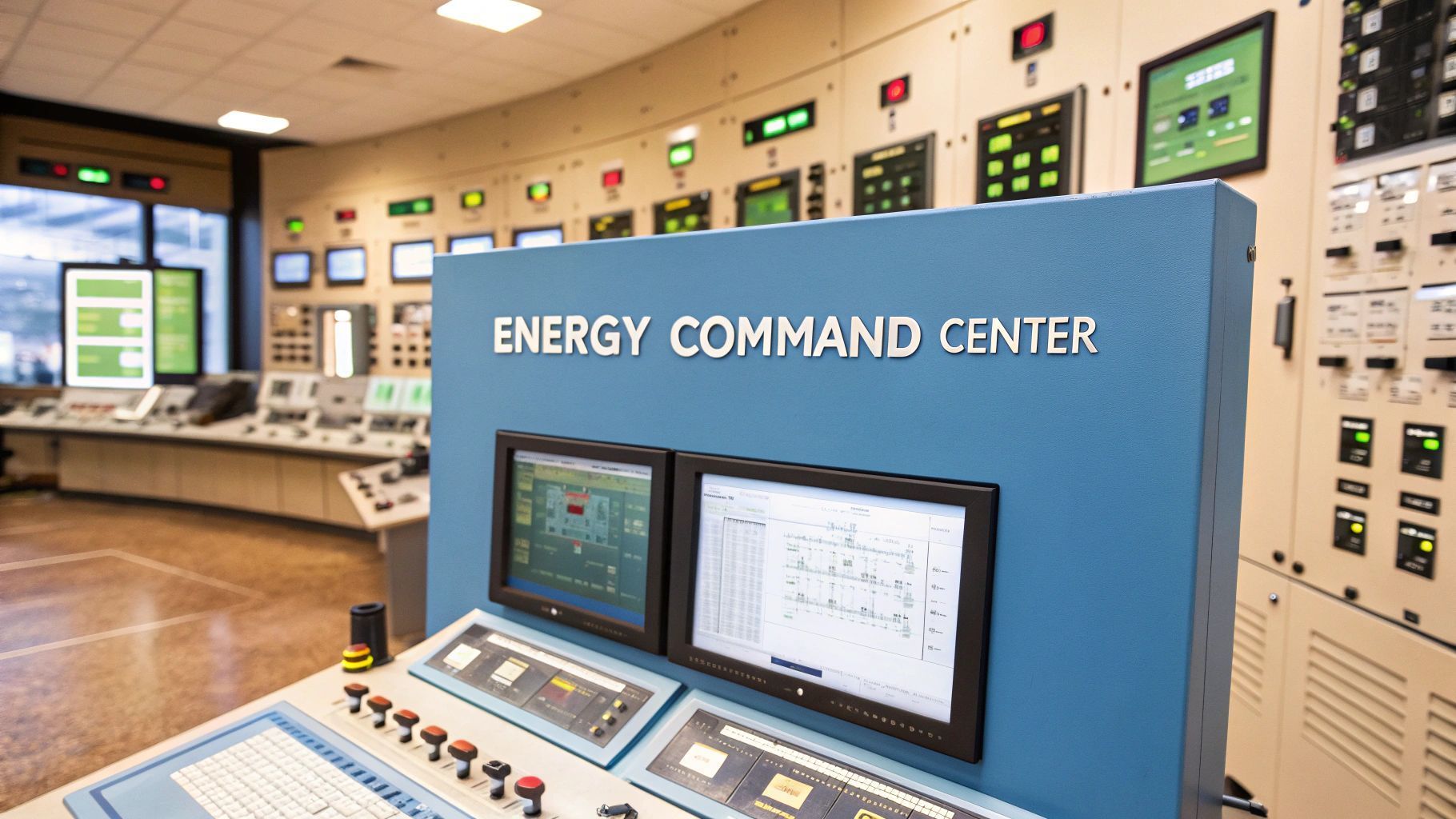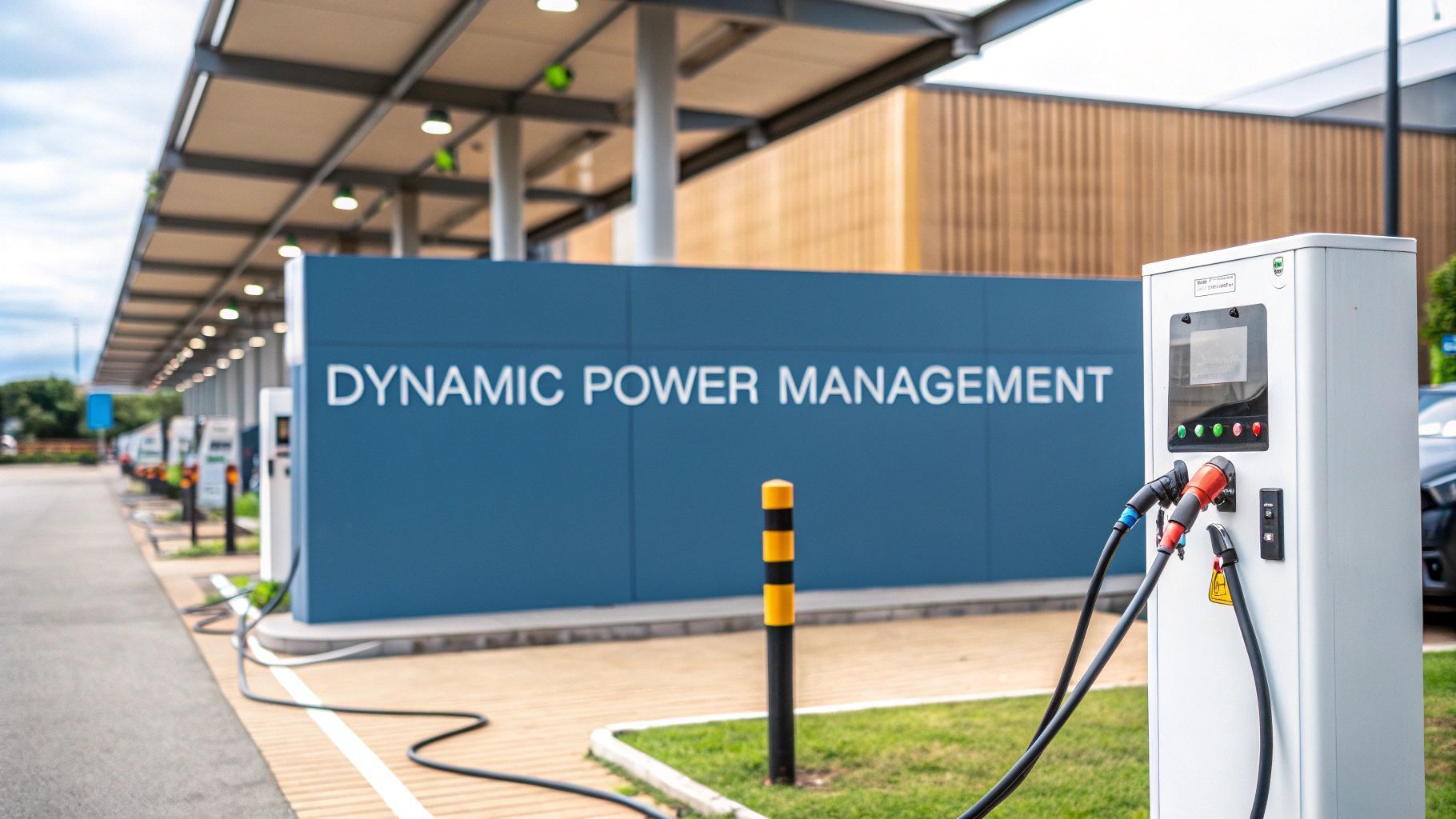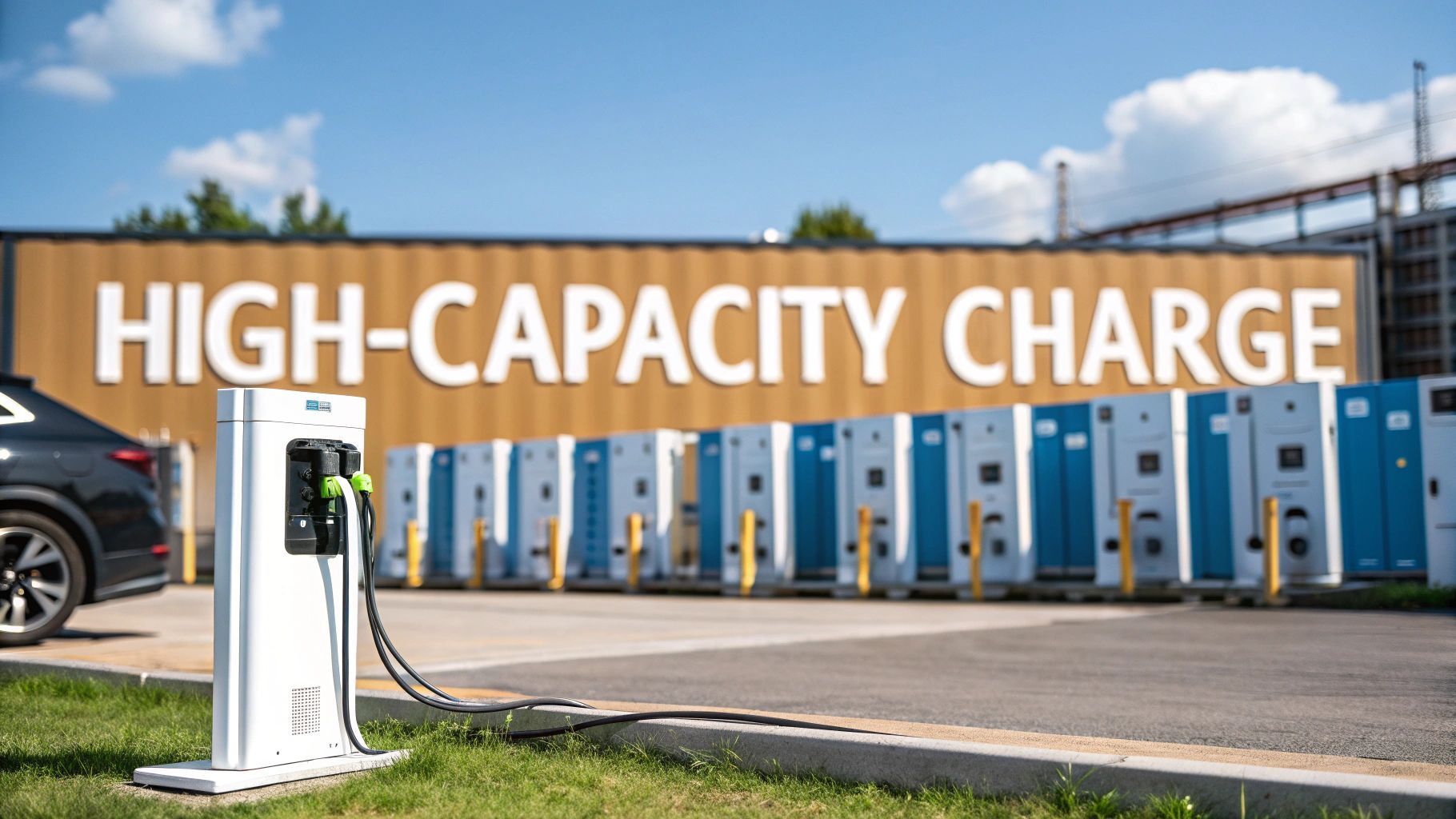Top 5 energy procurement strategies for UK fleets
As the UK transitions towards an electrified transport network, businesses and fleet operators face an increasingly complex energy puzzle. Traditional procurement models are often ill-equipped to handle the substantial demands of rapid and mobile EV charging, particularly when operating with constrained grid connections. The successful integration of on-site renewables, grid-scale batteries, and distributed energy systems now requires a more sophisticated and forward-thinking set of energy procurement strategies .
This guide is designed to cut through the complexity. We will detail ten essential strategies tailored to the unique challenges and opportunities facing modern commercial operations. From structuring Power Purchase Agreements (PPAs) for long-term stability to leveraging the flexibility of spot market purchasing, each approach offers a distinct path to optimising energy costs, enhancing supply resilience and achieving sustainability targets.
The goal is to provide a clear, actionable framework for securing cost-effective and reliable power for your entire EV charging ecosystem. Managing this infrastructure effectively is not just about procuring energy; it's also about safeguarding the hardware itself. Ensuring you have secure charging units is fundamental to protecting your investment and guaranteeing operational continuity. By adopting the right procurement tactics, you can build a resilient energy foundation that supports your fleet today and powers its growth tomorrow. Explore these proven methods to keep your operations charged, competitive and ahead of the curve.
1. On-Site Generation with Integrated Battery Storage
One of the most forward-thinking energy procurement strategies involves moving from a passive consumer to an active energy producer. This approach combines on-site renewable generation, typically solar photovoltaic (PV) panels, with a Battery Energy Storage System (BESS). This creates a powerful, self-sufficient microgrid that offers unparalleled control over energy costs, supply resilience and carbon emissions.
For businesses and fleets, especially those operating electric vehicles (EVs), this integrated system is a game-changer. It directly addresses the challenge of deploying rapid EV chargers on sites with constrained grid connections. The BESS can be charged during off-peak hours or from solar generation and then discharge its stored energy to meet the high-power demands of rapid EV charging, effectively bypassing the need for costly and time-consuming grid upgrades.
How It Works in Practice
This strategy transforms a business premises into a dynamic energy hub. Logistics depots, for instance, can utilise vast rooftop space for solar panels to generate clean electricity during the day. This energy can be stored in a BESS and used to power overnight Heavy Goods Vehicle (HGV) charging, significantly reducing reliance on expensive peak-rate grid electricity.
Similarly, commercial sites can install fully integrated rapid chargers that come with their own built-in battery storage, including mobile EV charging solutions. A prime example is the technology offered by specialists like ZPN Energy , which packages the charger and storage into a single unit. This allows retail parks to create public charging hubs with solar canopies, serving customers while generating revenue, without overwhelming the local distribution network.
Key Insight: This strategy is not just about procuring cheaper energy; it's about creating an entirely new energy asset. The combination of on-site renewables, EV charging and batteries provides a robust hedge against market volatility and enhances operational resilience against grid outages.
Actionable Implementation Tips
- Conduct a Feasibility Study: Start with a detailed site survey to assess your solar potential, available space for a BESS and existing grid connection limitations, especially for rapid EV charging.
- Model Your Energy Profile: Analyse your fleet's charging schedule, including potential mobile EV charging needs, and overall site consumption to correctly size the solar array and battery system for optimal peak shaving and self-consumption.
- Explore Alternative Financing: The initial capital outlay can be significant. Investigate asset financing or 'Energy as a Service' (EaaS) models where a third party owns and operates the system for a fixed monthly fee.
- Unlock New Revenue Streams: Ensure your BESS is configured to provide grid services, such as frequency response. This allows you to sell stored energy back to the grid and create an additional source of income from your distributed energy assets.
2. Renewable Energy Certificates (RECs) Trading
One of the most accessible and scalable energy procurement strategies is engaging with the market for Renewable Energy Certificates (RECs), also known as Guarantees of Origin (GoOs) in Europe. This market-based instrument allows organisations to stake a claim to the environmental benefits of green electricity generation without being physically connected to the renewable source. One REC represents the proof that one megawatt-hour (MWh) of electricity was generated and delivered to the grid from a renewable source.
For businesses and fleets, purchasing RECs is a straightforward way to meet sustainability targets and report lower Scope 2 emissions. It allows an organisation to match its grid electricity consumption, including that used for EV charging, with an equivalent volume of verified renewable generation. This is particularly useful for companies operating across multiple sites where on-site generation isn't feasible or for those seeking a flexible, non-capital-intensive green energy solution.
How It Works in Practice
This strategy decouples the physical electricity from its environmental attributes. When a wind farm or solar park generates 1 MWh of power, it creates two products: the electricity itself and one REC. A business can then purchase these RECs to match its own consumption, effectively subsidising the renewable generator and certifying its own energy use as green.
For example, a national logistics company can calculate the total annual electricity consumption of its EV charging depots and purchase an equivalent number of RECs from a specific wind farm project. This allows them to report that their entire EV fleet is powered by 100% renewable energy, a powerful claim for corporate social responsibility, even if the physical electrons powering their chargers come from the local grid mix.
Key Insight: RECs trading offers a flexible and immediate path to achieving renewable energy goals. It acts as a vital tool for companies to support the broader renewable energy market and credibly report on their sustainability commitments without the need for direct infrastructure investment.
Actionable Implementation Tips
- Choose High-Impact RECs: Not all RECs are equal. Prioritise purchasing from new renewable projects (a concept known as 'additionality') to ensure your investment is helping to bring new green capacity online.
- Verify with Credible Standards: Ensure your RECs are certified by a recognised body like Green-e in North America or through the European Energy Certificate System (EECS) to guarantee their legitimacy and prevent double-counting.
- Align Vintage with Consumption: Purchase RECs from a 'vintage year' (the year they were generated) that matches your company's reporting period to ensure your claims are accurate and auditable.
- Combine with Other Strategies: Use RECs to cover the portion of your energy use that cannot be met by on-site generation, creating a blended and more resilient approach to your overall energy procurement strategy.
3. Community Choice Aggregation (CCA)
Community Choice Aggregation (CCA) represents a powerful shift in local energy procurement, allowing local governments to pool, or aggregate, the electricity demand of their residents and businesses. This collective buying power enables them to negotiate more favourable terms with energy suppliers, often prioritising renewable sources over traditional fossil fuels. The incumbent utility still manages the grid infrastructure, transmission and billing but the CCA decides where the energy comes from.
This model is a strategic tool for communities aiming to achieve climate action goals and gain local control over their energy mix. For businesses and fleet operators within a CCA territory, this often translates to access to competitively priced, green electricity without having to negotiate individual Power Purchase Agreements. It simplifies the procurement of clean energy for distributed energy needs, which is essential for powering EV charging infrastructure and meeting corporate sustainability targets.
How It Works in Practice
A local government, or a group of them, forms a CCA entity that acts as the default electricity provider for its jurisdiction. The CCA then issues a request for proposals to find the best energy generation contracts that align with its community’s goals, such as higher renewable content or stable pricing. A notable example is Sonoma Clean Power in California, which provides customers with a higher percentage of renewable energy at competitive rates, driving local green energy projects.
For a fleet depot or a business with significant EV charging needs, being part of a CCA can de-risk its energy supply. The CCA manages the complexities of wholesale energy markets, providing a stable and often greener alternative to the standard utility offer. This allows the business to focus on its core operations while benefiting from a procurement strategy aligned with its environmental objectives.
Key Insight: CCAs democratise energy procurement, moving decision-making from distant utility boardrooms to the local community level. This strategy empowers businesses to participate in a larger, collective effort to decarbonise the grid while often securing more predictable energy costs.
Actionable Implementation Tips
- Engage with Local Authorities: If a CCA is being formed in your area, participate in public consultations to ensure the programme’s design meets the needs of commercial energy users, particularly those with high-demand EV charging.
- Analyse CCA Offerings: When a CCA launches, carefully compare its rate structures, renewable energy content and any specific programmes for businesses against the incumbent utility's offer to make an informed choice.
- Advocate for Commercial Tariffs: Work with the CCA to develop innovative tariffs, such as time-of-use rates optimised for EV fleet charging, which can further reduce your operational costs.
- Explore Local Energy Programmes: Many CCAs offer incentives for on-site solar, grid-scale batteries and energy efficiency upgrades. Investigate these to complement your broader distributed energy strategy and further reduce grid reliance.
4. Competitive Bidding Processes
A competitive bidding process, often managed through a Request for Proposal (RFP) or tender, is a foundational energy procurement strategy for securing favourable pricing and contract terms. This formalised approach involves soliciting detailed proposals from multiple energy suppliers, allowing organisations to compare offers on a like-for-like basis. It systemises procurement and moves it from a simple price comparison to a strategic evaluation of suppliers.
For large commercial entities and fleet operators, this method is crucial for managing significant energy expenditures, especially when planning for the high-demand loads of rapid EV charging infrastructure. By clearly defining needs such as supply capacity, contract length and risk tolerance, a business can compel suppliers to compete directly for its custom, ensuring the resulting contract is perfectly aligned with its operational and financial goals.
How It Works in Practice
This strategy is about creating a structured, competitive marketplace for your energy needs. A large logistics company preparing to electrify its HGV fleet, for instance, would issue a detailed RFP outlining its projected electricity demand, desired contract structure (e.g., fixed, flexible) and specific requirements for green energy certification.
Suppliers then respond with comprehensive bids detailing their pricing, the source of their energy and any value-added services. The company can then evaluate these proposals not just on the per-kWh rate but also on factors like the supplier's experience with high-demand EV charging clients and the flexibility of their terms. This structured comparison ensures the final decision is based on a holistic view of value rather than just the headline price.
Key Insight: This strategy shifts power from the seller to the buyer. By creating a transparent and competitive environment, you force suppliers to put their best offer forward from the outset, leading to optimised contract terms and significant cost avoidance.
Actionable Implementation Tips
- Define Your Needs Precisely: Before going to market, create a detailed specification document. Outline your expected consumption profile, including EV charging loads, your risk appetite and any sustainability requirements.
- Allow Adequate Response Time: A complex energy tender requires a thorough response. Give potential suppliers a minimum of 60 to 90 days to prepare a comprehensive and competitive proposal.
- Engage Procurement Experts: Use an experienced energy procurement advisor or consultant. They can help structure the tender, analyse bids and navigate complex contract negotiations, ensuring you achieve the best outcome.
- Conduct Pre-Tender Market Analysis: Before issuing the RFP, analyse current market conditions and forward price curves. This provides a crucial benchmark against which to evaluate the bids you receive.
5. On-Site and Distributed Generation (Solar/Wind)
One of the most direct and impactful energy procurement strategies is to become your own generator. This approach involves installing behind-the-meter renewable generation systems directly at your facilities, such as rooftop solar panels or small-scale wind turbines. It fundamentally changes a business's relationship with the grid from a passive consumer to an active, independent energy producer, enhancing resilience and cost control.
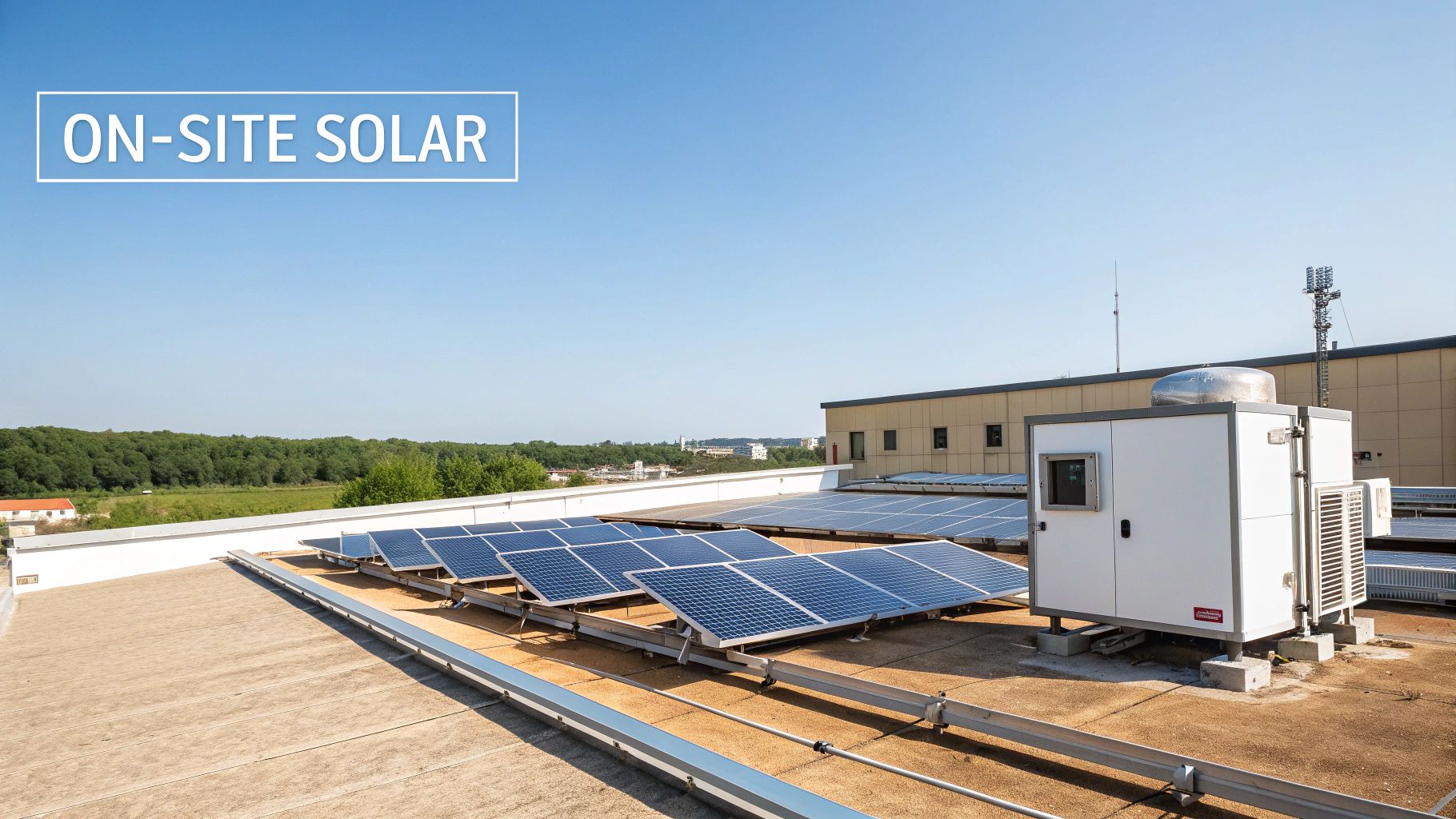
For organisations with significant land or roof space, like logistics centres or large retail outlets, on-site generation is a powerful tool to reduce electricity purchases from the grid. When combined with grid-scale batteries, it can power high-demand operations such as rapid EV charging, even on sites with constrained grid connections. This distributed energy model decentralises production, insulating the business from wider grid volatility and price spikes.
How It Works in Practice
This strategy involves harnessing local renewable resources to meet your immediate energy needs. A distribution centre can cover its vast roof with solar PV, generating clean electricity that powers warehouse operations and charges its electric fleet overnight. Similarly, corporate campuses, as demonstrated by companies like Apple, can achieve 100% renewable energy use on-site, showcasing a powerful commitment to sustainability while securing predictable energy costs.
Leading retailers like Costco have implemented nationwide rooftop solar programmes, turning their stores into mini power plants. This not only lowers their operational expenditure but also reduces the carbon footprint of each location. The key is to match the generation capacity to the site’s consumption profile, maximising self-consumption and minimising reliance on the grid.
Key Insight: On-site generation is more than a procurement tactic; it's a long-term capital investment in energy independence. It provides a direct hedge against rising energy prices and transmission costs, offering predictable power expenses for decades.
Actionable Implementation Tips
- Conduct a Thorough Resource Assessment: Before any investment, perform a detailed solar irradiance or wind speed study for your site to accurately forecast energy production and financial returns.
- Leverage Available Incentives: Explore government grants, tax credits and other local incentives designed to encourage renewable energy adoption to significantly reduce the initial capital outlay.
- Consider Third-Party Ownership Models: To minimise upfront costs, investigate Power Purchase Agreements (PPAs) or leasing options where a third party installs and maintains the system in exchange for a long-term contract.
- Integrate with Smart Technology: Combine your on-site renewables with smart inverters and an energy management system to optimise performance, monitor output and prepare for future integration with grid-scale batteries or EV charging infrastructure. Explore more on how to achieve this by learning about integrating renewable energy with advanced storage solutions.
6. Energy Portfolio Diversification
Instead of committing to a single supplier or contract type, this advanced energy procurement strategy applies the principles of financial investment to energy management. It involves strategically sourcing electricity from multiple channels, such as different suppliers, contract structures and generation types, to create a balanced and resilient portfolio. This method mitigates risk by ensuring the business is not overexposed to any single point of failure or price shock.
For businesses with significant and varied energy demands, like a logistics firm with a growing EV fleet and multiple depots, diversification is crucial. A blended approach might combine a long-term Power Purchase Agreement (PPA) for a large portion of their baseload demand with flexible spot market purchasing to capture price dips and on-site generation to offset daytime charging costs. This protects against market volatility while pursuing cost-saving opportunities.
How It Works in Practice
This strategy moves beyond simply finding the cheapest tariff. A large fleet operator might secure 60% of its required energy via a fixed-price contract to guarantee budget certainty for its core operations. A further 20% could be sourced from a renewable PPA, locking in green credentials and a predictable long-term price.
The remaining 20% might be procured from the day-ahead market, allowing the company to charge its EV fleet opportunistically when wholesale prices are low or even negative. Companies like Microsoft exemplify this at scale, blending PPAs with on-site solar and other instruments to achieve their sustainability and cost objectives. This layered approach creates a robust defence against unpredictable market swings.
Key Insight: Portfolio diversification transforms energy procurement from a simple transaction into an active risk management function. By balancing different contract lengths, price mechanisms and energy sources, a business can build a customised energy profile that aligns with its specific risk tolerance and operational needs.
Actionable Implementation Tips
- Define Your Risk Appetite: Formally establish your organisation’s tolerance for price volatility. This will determine the ideal mix of fixed, flexible and self-generated energy sources in your portfolio.
- Utilise Portfolio Modelling: Engage with an energy consultant or use specialised software to model different scenarios. This helps to optimise the blend of contracts based on your consumption patterns and market forecasts.
- Balance Contract Durations: Combine short-term flexible contracts that offer agility with long-term PPAs that provide price stability. This layered approach hedges against both immediate price spikes and long-term market inflation.
- Integrate On-Site Assets: Actively incorporate your combined on-site renewables and grid-scale batteries into the portfolio. These distributed energy assets can be used to avoid high grid prices or even generate revenue, adding another layer of financial control.
7. Utility Green Energy Programs
For businesses seeking a straightforward and accessible route to decarbonise their electricity supply, participating in utility green energy programmes is a highly effective energy procurement strategy. This approach allows organisations to source renewable energy directly from their existing electricity supplier, often by paying a small premium to ensure their consumption is matched with generation from renewable sources like wind, solar or hydro.
This method is particularly advantageous for businesses without the physical space or capital for on-site generation, or for those leasing their premises. It provides a simple, low-risk way to meet corporate sustainability goals and demonstrate environmental commitment without the operational complexities of managing physical assets. By opting into these programmes, businesses can support the growth of renewable energy generation on the wider grid.
How It Works in Practice
A business or fleet operator simply contacts their utility provider and enrols in their voluntary green tariff or renewable energy programme. The utility then guarantees that a specified percentage, often 100%, of the customer's electricity usage is sourced from renewable generators. The utility manages the procurement and retirement of the associated Renewable Energy Guarantees of Origin (REGOs) on the customer's behalf, providing a certified green energy supply.
For example, a logistics company can power its entire network of depots and EV chargers with certified renewable electricity by signing up for a programme like EDF's Renewable for Business tariff. This allows them to report near-zero Scope 2 emissions for their electricity consumption across all sites, a crucial benefit for sustainability reporting and attracting environmentally conscious clients, without needing to install a single solar panel themselves.
Key Insight: This strategy offers a powerful combination of simplicity and impact. It democratises access to renewable energy, allowing organisations of any size to contribute to the energy transition and meet their sustainability targets with minimal administrative overhead.
Actionable Implementation Tips
- Compare Programme Specifics: Investigate the details of your utility's green tariff. Look for transparency in how they source renewables and ensure they are retired on your behalf to avoid double-counting.
- Analyse the Premium: Carefully evaluate the cost premium (the 'green premium') against the benefits of achieving your sustainability goals and enhancing your brand reputation. Compare this cost to other procurement options.
- Seek Long-Term Rate Stability: Some utility programmes offer the option to lock in the green tariff rate for a set period. This can provide budget certainty and protect your business from future volatility in the renewables market.
- Integrate with a Broader Strategy: Use a utility green programme as a foundational step. It can cover your baseline energy needs while you explore other strategies, like installing a grid-scale battery for peak shaving at a key site.
8. Aggregated Group Procurement
For smaller organisations, fleets, or local authorities, the scale required to negotiate favourable energy contracts can seem out of reach. Aggregated group procurement is a powerful strategy that levels the playing field by pooling the collective energy demand of multiple entities. This collective bargaining power allows the group to access wholesale market prices and sophisticated contracts typically reserved for major corporations.
This approach is particularly effective for groups of businesses operating in the same industrial park, a consortium of local councils, or even a collection of fleet depots looking to secure electricity for their EV charging infrastructure. By combining their consumption profiles, they create a much larger and more attractive portfolio for energy suppliers, enabling them to negotiate better rates, more flexible terms and greener energy products than they could achieve individually.
How It Works in Practice
This strategy involves forming a purchasing consortium where members agree to procure energy under a single, unified agreement. A professional energy consultant or a lead organisation typically manages the tender process, analysing the group's collective energy usage, defining shared objectives and negotiating with suppliers on behalf of all members.
For example, a group of logistics companies could form a cooperative to purchase the electricity needed for their overnight HGV and van charging. This not only reduces the unit cost of electricity but also allows them to collectively purchase Renewable Energy Guarantees of Origin (REGOs) to meet sustainability targets more affordably. Similarly, organisations like the Illinois Municipal Electric Cooperative (IMEC) demonstrate how municipalities can band together to achieve significant cost savings and supply stability for their communities.
Key Insight: This strategy democratises access to sophisticated energy procurement. It transforms multiple small, less influential consumers into a single, large entity with the market leverage to drive down costs and secure advantageous contract terms.
Actionable Implementation Tips
- Establish Clear Governance: Create a formal agreement outlining decision-making processes, member responsibilities and how costs and savings will be shared equitably across the group.
- Engage Professional Management: Utilise an experienced energy procurement consultant to manage the complex tendering and negotiation process, ensuring the group secures the best possible outcome.
- Standardise Contract Needs: While individual needs may vary slightly, work to develop a standardised set of core requirements for the energy contract to present a unified front to suppliers.
- Maintain Strong Communication: Regular and transparent communication is vital to keep all stakeholders aligned on objectives, progress and outcomes throughout the procurement lifecycle.
9. Real-Time and Spot Market Purchasing
For organisations with significant energy consumption and a high tolerance for risk, engaging directly with wholesale electricity markets offers a dynamic and potentially cost-saving procurement strategy. This approach involves purchasing electricity at day-ahead or even real-time hourly rates directly from the spot market, rather than locking into a fixed-price contract. It allows sophisticated consumers to capitalise on periods of low prices, such as when renewable generation is high and demand is low.
This method transforms a business from a passive price-taker into an active market participant. It is particularly relevant for operations with flexible demand, such as fleets that can schedule EV charging based on price signals, or sites with grid-scale batteries that can charge when prices are low and discharge when high. Tech giants like Amazon and Google have pioneered this approach, using advanced forecasting and trading operations to optimise their massive energy spend in real-time.
How It Works in Practice
This advanced strategy requires a deep understanding of market dynamics and robust internal systems. A depot with a large EV fleet and a grid-scale battery could monitor day-ahead market prices and schedule vehicle and battery charging for overnight, when prices are typically lower. This requires not only market access but also sophisticated forecasting tools to predict both market prices and the site's own consumption needs with a high degree of accuracy.
Success hinges on managing the inherent volatility. While the potential for savings is significant, so is the exposure to price spikes. Therefore, this strategy is almost always paired with financial hedging instruments, like futures or options, to create a price ceiling and protect against extreme market events. For more details on this advanced form of energy management, you can learn more about grid energy management at zpnenergy.com.
Key Insight: Direct market purchasing is the ultimate active energy procurement strategy, turning energy from a fixed overhead into a variable cost that can be actively managed. It rewards flexibility and data-driven decision-making with the potential for substantial cost reductions.
Actionable Implementation Tips
- Implement AI and ML Forecasting: Use artificial intelligence and machine learning algorithms to accurately predict your site's energy demand and forecast short-term market price movements.
- Establish Robust Risk Protocols: Define clear risk management protocols, including stop-loss limits and hedging strategies, to protect your budget from unpredictable price spikes.
- Invest in Energy Management Systems: Deploy advanced Supervisory Control and Data Acquisition (SCADA) or Energy Management Systems (EMS) for real-time monitoring and control of energy consumption.
- Partner with Trading Experts: If you lack in-house expertise, consider partnering with an energy trading firm or consultant who can manage market participation on your behalf.
10. Energy Efficiency and Demand-Side Management
The most effective energy procurement strategies often begin by reducing the amount of energy you need to buy in the first place. This approach focuses on optimising consumption through energy efficiency improvements and sophisticated demand-side management. By upgrading infrastructure and modifying operational behaviours, organisations can significantly lower their baseline energy demand, making all other procurement efforts more impactful and cost-effective.
This strategy involves a holistic review of energy use, from upgrading to LED lighting and optimising HVAC systems to deploying smart building controls that automate energy savings. For businesses with energy-intensive operations, such as fleets requiring rapid EV charging from constrained grid connections, managing demand is crucial. It prevents unnecessary strain on the grid and avoids punitive peak demand charges, directly reducing operational costs.
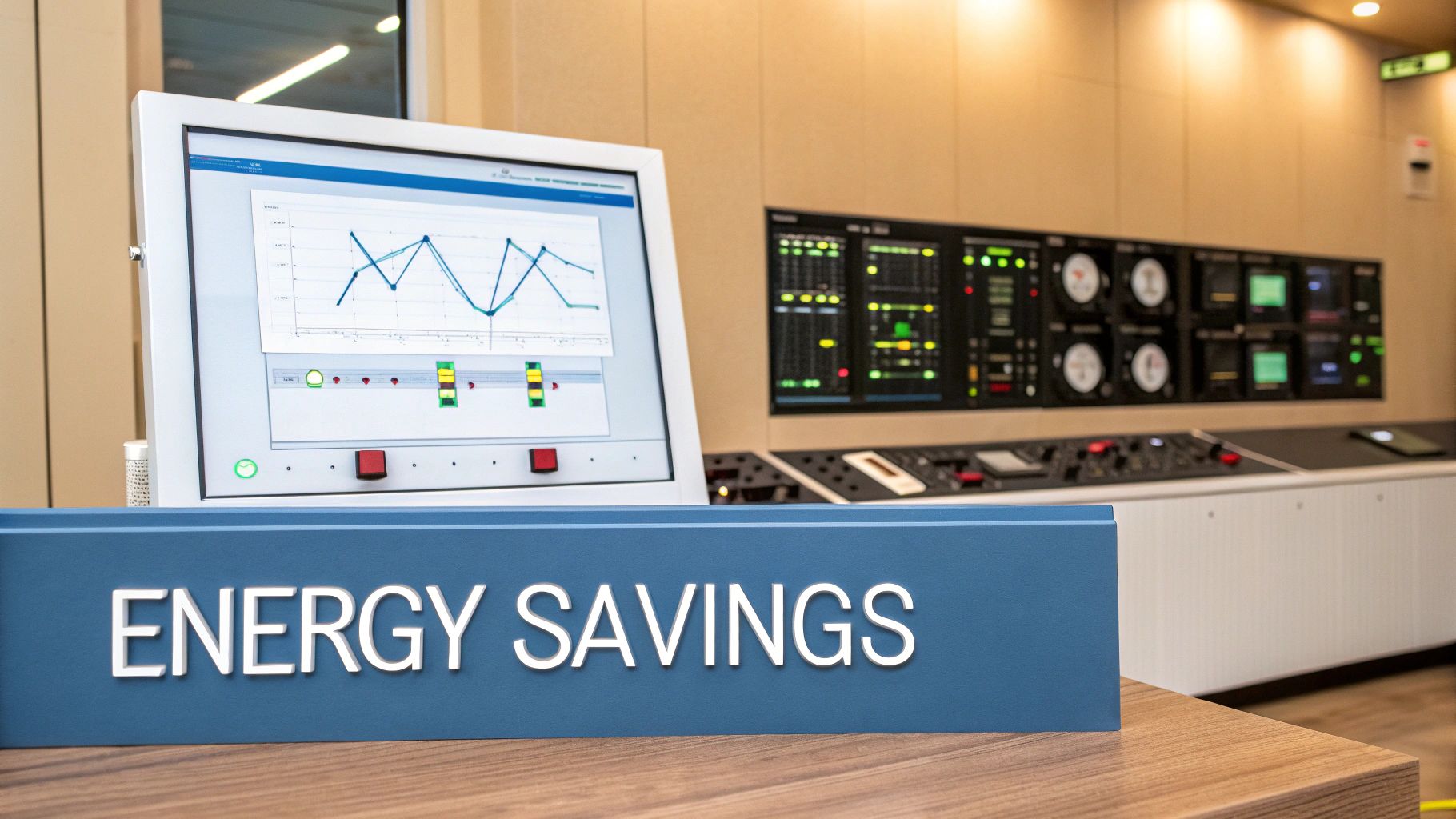
How It Works in Practice
Demand-side management systematically identifies and eliminates energy waste. A fleet depot, for example, might implement a smart charging system that schedules EV charging to coincide with low-cost, off-peak electricity tariffs or periods of high on-site renewable generation. This avoids the high prices and grid stress associated with charging during peak hours.
Major corporations have demonstrated the power of this approach. Johnson & Johnson's comprehensive efficiency initiatives and Google’s relentless optimisation of its data centres have set global benchmarks, proving that efficiency is a powerful competitive advantage. These programmes integrate technology with behavioural changes, creating a culture of continuous energy improvement that delivers lasting financial and environmental benefits. Explore advanced techniques with our guide to business energy management.
Key Insight: This strategy treats energy efficiency not as a one-off project but as a foundational business practice. Reducing demand is the cheapest and cleanest way to manage energy costs, providing a high-return investment that enhances resilience and sustainability.
Actionable Implementation Tips
- Conduct a Comprehensive Energy Audit: Engage a professional to perform a detailed audit of your facilities and operations to identify the most significant sources of energy waste and potential savings.
- Prioritise High-Impact Measures: Focus initial efforts on 'quick wins' like LED lighting retrofits and HVAC optimisation, which typically offer the fastest payback periods.
- Leverage Rebates and Incentives: Investigate government grants and utility company rebate schemes designed to offset the capital cost of energy efficiency upgrades.
- Implement Continuous Monitoring: Use sub-metering and energy management software to track consumption in real-time, enabling you to verify savings and identify new opportunities for optimisation.
Top 10 Energy Procurement Strategies Compared
| Strategy | Implementation Complexity 🔄 | Resource Requirements ⚡ | Expected Outcomes 📊 | Ideal Use Cases ⭐ | Key Advantages / Tips 💡 |
|---|---|---|---|---|---|
| Power Purchase Agreements (PPAs) | High — lengthy negotiations, legal complexity | Moderate–High — credit requirements, long-term commitment | Strong price stability and guaranteed renewable supply | Large corporates or buyers needing long-term price certainty | Enables project finance; negotiate flexibility and termination clauses |
| Renewable Energy Certificates (RECs) Trading | Low — market transactions and verification | Low — pay-as-you-go purchases | Flexible compliance claims; limited physical grid impact | Organizations needing scalable, low-cost renewable attribution | Cost-effective and scalable; match vintage and verify additionality |
| Community Choice Aggregation (CCA) | Medium — municipal setup, regulatory approval | Moderate — administrative and startup costs | Localized higher-renewable mixes; potential rate savings | Cities/regions seeking community control of supply | Aggregated buying power; build community engagement and governance |
| Competitive Bidding Processes | High — RFP design, evaluation, contracting | Moderate — procurement team and advisory costs | Market-driven optimal pricing; defensible procurement outcomes | Utilities, municipalities, large volume buyers | Transparent price discovery; allow adequate time (60–90 days) for bidders |
| On-Site & Distributed Generation (Solar/Wind) | Medium — technical design, permitting, interconnection | High upfront capital (offset by incentives) | Reduced grid dependence, long-term cost protection, resilience | Facilities with suitable roof/land and resiliency needs | Immediate energy independence; leverage incentives or PPAs to reduce capex |
| Energy Portfolio Diversification | High — ongoing portfolio management complexity | Moderate–High — analytics, staffing, multiple contract types | Lower volatility, balanced cost-reliability trade-offs | Large organizations managing market and supply risk | Use modeling tools; rebalance regularly to match risk tolerance |
| Utility Green Energy Programs | Low — simple opt-in enrollment through utility | Low — premium on utility bill | Standardized renewable supply with limited customization | Customers preferring easy, utility-managed options | Simple enrollment; compare program sourcing and additionality |
| Aggregated Group Procurement | Medium — coordination, governance and shared decision-making | Low–Moderate per member — shared costs reduce individual burden | Improved pricing and negotiating leverage for members | Small orgs or municipalities pooling demand to access better terms | Establish clear governance, cost-sharing rules and standard contracts |
| Real-Time & Spot Market Purchasing | Very High — requires real-time systems and trading expertise | High — working capital, advanced tech and hedging capacity | Potential for significant cost savings but high volatility risk | Large industrials or tech firms with trading operations | Require AI/ML forecasting, robust hedging and strict risk controls |
| Energy Efficiency & Demand-Side Management | Medium — audits, retrofits, and ongoing operations | Moderate–High upfront (offset by rebates and savings) | Lowest-cost energy reductions; strong ROI and reduced peak demand | All organizations seeking cost-effective, long-term savings | Start with energy audit; prioritize high-impact measures and continuous monitoring |
Building a Resilient and Cost-Effective Energy Future
The journey towards an optimised energy future is not about finding a single, perfect solution. Instead, it involves crafting a bespoke, multi-layered approach that transforms your organisation from a passive energy consumer into a proactive, strategic market participant. As we have explored, the landscape of energy procurement strategies is rich with opportunities, each offering unique advantages tailored to specific operational needs, geographical constraints and long-term sustainability goals. From the long-term price certainty of Power Purchase Agreements (PPAs) to the flexibility of real-time spot market purchasing, the right combination of tactics can unlock significant cost savings and build unprecedented operational resilience.
The key takeaway is that static, set-and-forget energy contracts are becoming a relic of the past. The modern energy ecosystem, particularly for organisations integrating EV charging, on-site renewables, and grid-scale batteries, demands a dynamic and diversified portfolio. Relying solely on a traditional utility tariff is no longer sufficient when faced with volatile wholesale prices, constrained grid connections and the increasing need for reliable, clean power. By embracing distributed energy strategies like combined on-site renewables with EV charging and batteries, businesses can insulate themselves from market shocks, reduce their carbon footprint and even create new revenue streams from their energy assets.
From Strategy to Action: Your Next Steps
Moving forward requires a shift in mindset and a commitment to active energy management. The strategies detailed in this article provide a comprehensive roadmap but successful implementation hinges on a clear, actionable plan. Consider the following steps to begin your transformation:
- Conduct a Comprehensive Energy Audit: You cannot manage what you do not measure. Start by thoroughly analysing your current energy consumption patterns, peak demand periods and existing infrastructure. This data is the foundation for every strategic decision, helping you identify the most significant opportunities for improvement.
- Define Your Core Objectives: Is your primary goal cost reduction, carbon neutrality, energy independence, or operational resilience? While these goals are interconnected, prioritising them will help you select the most suitable procurement strategies. A fleet operator concerned with uptime during grid outages will prioritise on-site generation and grid-scale batteries, whereas a business focused purely on its ESG targets might lean towards PPAs and Renewable Energy Certificates.
- Model and Evaluate Scenarios: Do not commit to a single path without exploring the alternatives. Use your audit data to model the financial and operational impact of different strategies. How would an on-site solar and battery system perform against a long-term PPA? What are the potential savings from participating in a group purchasing scheme versus navigating the spot market?
- Seek Expert Guidance: The energy market is complex and the technology is evolving rapidly. Partnering with specialists who understand the intricate interplay between grid services, EV charging infrastructure, grid-scale batteries and procurement can de-risk your investment and accelerate your return. This expertise is crucial for navigating regulatory hurdles and integrating diverse technologies into a cohesive, optimised system.
Ultimately, mastering these energy procurement strategies is about more than just lowering your electricity bill; it is about future-proofing your organisation. For a deeper dive into financial optimisation, consider exploring these high-impact cost reduction strategies which complement the energy-focused approaches discussed here. By taking control of your energy destiny, you build a powerful competitive advantage, turning a traditional operational cost into a strategic asset that powers growth, sustainability and long-term success.
Ready to turn your strategic vision into a tangible reality? ZPN Energy specialises in delivering integrated solutions that combine rapid EV charging, grid-scale battery storage and intelligent energy management systems. We help organisations overcome grid constraints and implement advanced energy procurement strategies with our cutting-edge technology. Discover how ZPN Energy can power your future.


